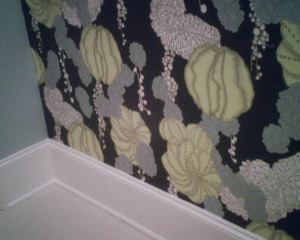Most wallpaper patterns have either a straight match (all key design elements appear at the top of the wall at the ceiling line, for instance) or a drop match (every other key design element is at the top of the wall at the ceiling).
This pattern by Walnut had what’s called a multiple drop match, which means that the design element moved up and down the wall several times, before appearing for a second time at the top of the wall at the ceiling.
Multiple drop matches are not very common, and the manufacturer generally does not mark the product as such so you don’t know what you are dealing with, they can eat up a lot of paper, they can be extremely difficult to figure out, and it’s questionable as to whether or not they look pleasing on the wall.
I needed five strips of paper, each 8′ long, to cover this accent wall. That’s 40′. I had only 45′ of paper, which does not leave much for trimming at the floor and ceiling, and for matching the pattern – which was a very long 36.” To make things even more tight, I thought this was a simple drop match, and had already cut two strips, before I realized that something was amiss.
This paper was 27″ wide. Most all patterns will repeat horizontally, with either a straight or a drop match, within that 27″ width. But this pattern took two 27″ widths to make up the design, so the pattern repeated horizontally at a width of 54″.
In addition to that, the pattern had a multiple drop, which meant that each 54″ wide design did not repeat horizontally at 54″ and show up at the top of the wall at the ceiling line, but instead started to drop down the wall by a small amount.
As the pattern played out across the wall, the yellow sea urchins moved down from the ceiling line by a few inches with each horizontal pattern repeat.
To complicate things more, the designer used the same sea urchin motif at several points across the pattern, but he used different backgrounds … Look closely at the sea cucumbers and coral and hanging berries that surround the sea urchins – At first glance, these appear the same, but actually are different. Which makes it very complicated to ferret out the proper pattern match.
Once I snapped to the odd multiple-drop pattern match, and, factoring in the limited amount of paper that we had, and the fact that I had already cut two strips of identical pattern match, I spent about an hour and a half measuring, marking, plotting, rolling out right side up, rolling out upside down, etc., before I actually cut any strips, because I wanted to be sure we had enough paper to cover the wall.
Wall? Yes, one wall. Whew! I am glad it was only one accent wall, because I would have been sorely taxed to have had to have dealt with this crazy multiple drop pattern match for an entire room! And it would have consumed a whole lot more paper, too.
So the multiple-drop pattern match designs are complex and time-consuming. But, once they are figured out and up on the wall, do they look good? In this case, and in the case of the last one I did recently ( https://wallpaperlady.wordpress.com/2016/10/08/crazy-wacky-mid-century-modern-look/ ), I have to say that I’m not crazy about them.
On one hand, the wide span of the design, and the disparate placement on the wall breaks up the rhythm of the pattern that can get repetitive and monotonous. But on the other hand, generally, the eye wants to see the same motif appearing at the top of the wall regularly. If the motif drops down instead, it can look either like the ceiling line is grossly un-level, or that the paperhanger has done a bad job of keeping the motif at the top of the wall.
Besides, these multiple-drop pattern matches are just too darned much work. And they use up / waste a lot more paper. I can’t remember having encountered this in the last 10 years – let’s hope it will be another 10 years before it pops up again! 🙂
Tags: ceiling line, drop, multiple drop, pattern match, straight, wallpaper, Walnut



Leave a comment